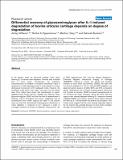| dc.contributor.author | Williams, Ashley | |
| dc.contributor.author | Oppenheimer, Rachel A | |
| dc.contributor.author | Gray, Martha L. | |
| dc.contributor.author | Burstein, Deborah | |
| dc.date.accessioned | 2011-11-01T14:22:38Z | |
| dc.date.issued | 2003 | |
| dc.identifier.citation | Williams, Ashley, Rachel A. Oppenheimer, Martha L. Gray, and Deborah Burstein. 2003. Differential recovery of glycosaminoglycan after IL-1-induced degradation of bovine articular cartilage depends on degree of degradation. Arthritis Research & Therapy 5(2): R97-R105. | en_US |
| dc.identifier.issn | 1478-6354 | en_US |
| dc.identifier.uri | http://nrs.harvard.edu/urn-3:HUL.InstRepos:5332857 | |
| dc.description.abstract | In the present study we examined cartilage matrix repair following IL-1-induced matrix depletion. Previous data indicated that, in some cases, chondrocytes can synthesize macromolecules to establish a functional extracellular matrix in response to a matrix-damaging insult or when placed in a three-dimensional environment with inadequate matrix. However, the conditions under which such 'repair' can occur are not entirely clear. Prior studies have shown that chondrocytes in trypsin-depleted young bovine articular cartilage can replenish tissue glycosaminoglycan (GAG) and that the rate of replenishment is relatively uniform throughout the tissue, suggesting that all chondrocytes have similar capacity for repair. In the present study we used the characteristic heterogeneous distribution of matrix depletion in response to IL-1 exposure in order to investigate whether the severity of depletion influenced the rate of GAG replenishment. We used the delayed Gadolinium-Enhanced Magnetic Resonance Imaging of Cartilage (dGEMRIC) method to monitor the spatial and temporal evolution of tissue GAG concentration ([GAG]). For both mild (n=4) and moderate (n=10) IL-1-induced GAG depletion, we observed partial recovery of GAG (80% and 50% of baseline values, respectively) over a 3-week recovery period. During the first 2 weeks of recovery, [GAG] increased homogeneously at 10–15 mg/ml per week. However, during the third week the regions most severely depleted following IL-1 exposure showed negligible [GAG] accumulation, whereas those regions affected the least by IL-1 demonstrated the greatest accumulation. This finding could suggest that the most severely degraded regions do not recover fully, possibly because of more severe collagen damage; this possibility requires further examination. | en_US |
| dc.language.iso | en_US | en_US |
| dc.publisher | BioMed Central | en_US |
| dc.relation.isversionof | doi://10.1186/ar615 | en_US |
| dc.relation.hasversion | http://www.ncbi.nlm.nih.gov/pmc/articles/PMC165027/pdf/ | en_US |
| dash.license | LAA | |
| dc.subject | chondrocyte | en_US |
| dc.subject | dGERMIC | en_US |
| dc.subject | glycosaminoglycan | en_US |
| dc.subject | magnetic resonance imaging | en_US |
| dc.subject | regeneration | en_US |
| dc.title | Differential Recovery of Glycosaminoglycan After IL-1-Induced Degradation of Bovine Articular Cartilage Depends on Degree of Degradation | en_US |
| dc.type | Journal Article | en_US |
| dc.description.version | Version of Record | en_US |
| dc.relation.journal | Arthritis Research & Therapy | en_US |
| dash.depositing.author | Gray, Martha L. | |
| dc.date.available | 2011-11-01T14:22:38Z | |
| dash.affiliation.other | HMS^Health Sciences and Technology | en_US |
| dash.affiliation.other | HMS^Radiology- Beth Israel-Deaconess | en_US |
| dash.affiliation.other | HMS^Health Sciences and Technology | en_US |
| dc.identifier.doi | 10.1186/ar615 | * |
| dash.contributor.affiliated | Gray, Martha | |
| dash.contributor.affiliated | Burstein, Deborah | |


